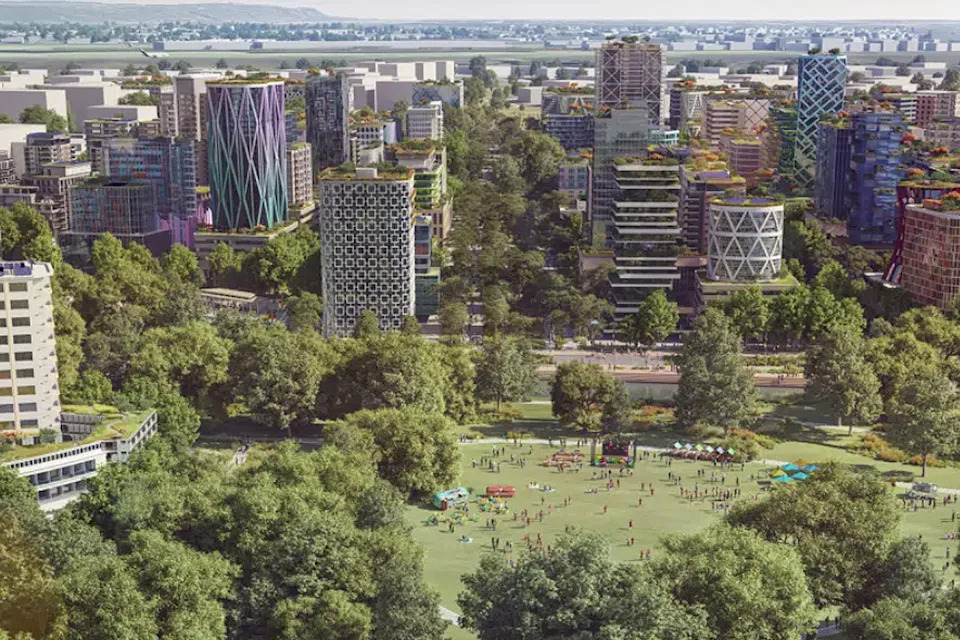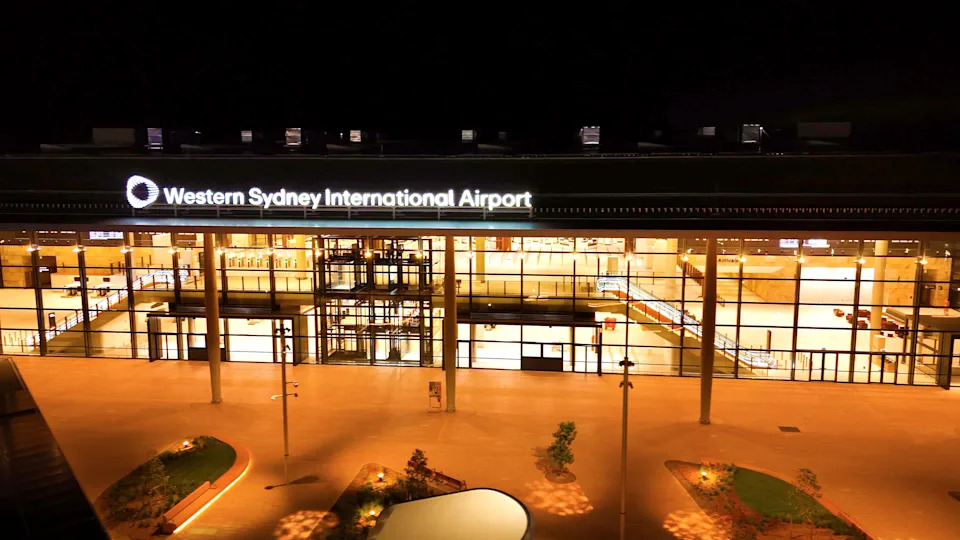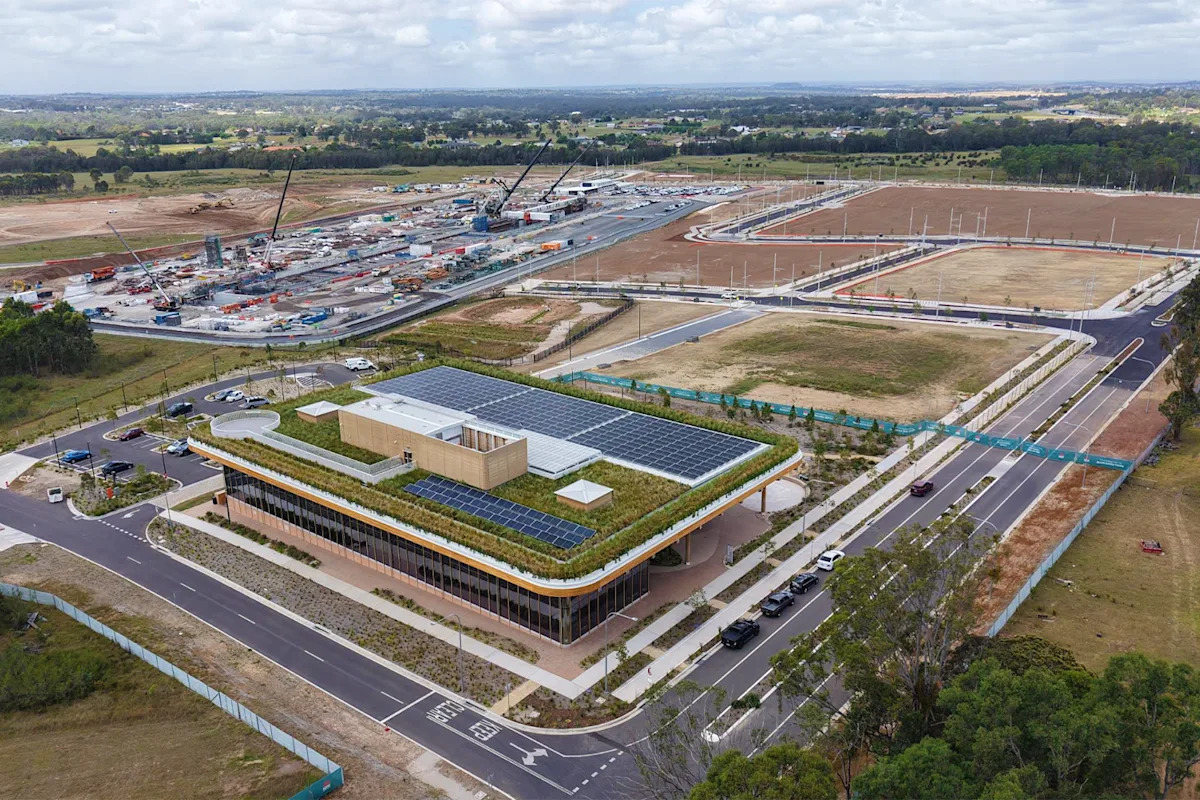Bradfield City is billed as Australia's first entirely new city in more than 100 years – an “ultra-high-tech” city center that promises jobs, innovation and sustainable design in Sydney's far west.
It is adjacent to the new Western Sydney International Airport, which welcomed its first-ever flight just before 9am on Tuesday, marking a major milestone in the development.
Bradfield lies in one of New South Wales' hottest corridors, where temperatures regularly rise above 40 degrees in summer. The $1 billion development aims to redefine urban growth – a “green and connected” alternative to the sprawling, car-dependent suburbs that dominate the region.
But as excitement grows over the futuristic project, experts warn that the biggest challenge may not be attracting residents or investors, but rather beating the heat.

An artist's impression of what the new Bradfield City in Sydney's far west will look like. Source: NSW Government
Built for the future – but can Bradfield stand up to the heat?
Some experts say it remains to be seen whether the technology and clever design can truly outsmart the climate.
The Bradfield Development Authority told Yahoo News that the city's master plan embeds “climate-smart principles into every level of planning and implementation” and includes more than 36 hectares of open space, a two-hectare Central Park and a 2.2-kilometer “Green Loop” connecting streets and parkland.
An ambitious target of 40 per cent tree canopy – twice the level of most Sydney suburbs – aims to cool the landscape, along with shaded promenades, water-sensitive design and a unique digital network of smart poles that provide lighting, Wi-Fi and e-bike charging.
The city's first landmark, known simply as the First Building and pictured above, sets the tone. The roof features a self-sufficient “biosolar” ecosystem of 14,000 native plants and 319 solar panels, which together cool the roof surface in summer and insulate it in winter. So far it has won twelve design awards, including the Good Design Award 2025 for sustainability.
But as climate researcher Dr. As Monash University's Lucy Richardson points out, success will depend on whether these measures are embedded in the city's DNA – and not just in its marketing.
“It's great to see these issues being addressed from the outset. Urban heat is a significant issue for most Australian cities and Western Sydney is one of the hardest hit cities,” she told Yahoo News Australia.
“Predictions about the likely impacts of climate change suggest that this condition will only worsen until emissions are curbed, and even for some time thereafter due to the inertia of the climate system.”
Richardson emphasized that embedding climate-smart measures into the city's initial planning – as they can be integrated into road layouts, drainage, water supply, zoning and building standards – gives Bradfield the best chance of effective thermal management. Retrofitting these solutions later would be much more difficult, she said, and unlikely to achieve the same level of effectiveness or efficiency.
When high-tech isn't enough
RMIT urban planner Professor Joe Hurley agrees that glossy technology alone will not make Bradfield livable. He pointed out that heatwaves in Australian cities caused more deaths than fires or floods.
Neighboring Badgery's Creek saw two days above 37 degrees last week, and on January 4, 2020, the temperature there reached a record 47.6 degrees.
“With new developments like Bradfield, it is important that we create urban landscapes that are heat resilient,” he said. “Western Sydney experiences some of the most significant urban heat conditions in Australian cities due to its climate, extensive development and relatively low vegetation cover.”
Hurley said elements such as green roofs, treetop targets, shaded streets and reflective materials can play a role in reducing heat exposure. “But the key here is that it’s the cumulative impact that matters – a few green roofs may look good in marketing materials, but will have little impact at the neighborhood level,” he said.
Ultra-high-tech is not synonymous with a livable, inclusive and resilient environment.
“Technology may support these goals, but it often distracts from more substantive efforts at good design and infrastructure delivery.”
Transportation, trees and timing are key
Sydney-based head of strategic transport policy and planning Matt Faber believes linking sustainable design, density and transport can make or break Bradfield. Faber said the city's plans look good on paper, particularly the addition of a rail link, but success will depend on the timing and sequence of infrastructure. “It's not just about building the railway. You need schools, parks, local businesses, childcare and other social infrastructure first,” he said.
“Everyone knows that trees mitigate heat,” he said. “You can’t do this soon enough.”
Faber said it will be crucial to “break up large areas of concrete.” “There is no need to build six lanes at once,” he said. “Maybe you build four, give a bus company lanes, and then use the extra width you may have saved to plant a lot of trees, so that when people move in, those trees are already established and you get some sort of cooling effect from them.”
Faber said at this stage whether Bradfield “will in reality lead to sustainable urban development is very questionable”. He also warned that developers alone cannot create the kind of community Bradfield seeks.
“There is a need for leadership at all three levels of government,” he said. “Of course the state government has to take the lead, but the municipalities also have to be much more involved.”
Despite the challenges, Faber sees great potential for Bradfield. “With careful planning … there is no reason why it cannot be a thriving city,” he said. The question, Faber added, is whether the early stages will be managed well enough to avoid the pitfalls we see in other new suburbs.

The new Western Sydney Airport is scheduled to open at the end of 2026. Source: Getty
Creating a city takes more than just buildings
Professor Nicky Morrison of Western Sydney University is also closely monitoring the danger of a hollow, infrastructure-focused “dorm suburb”. She said there is a great opportunity to plan a city properly from the start, integrating land use, transport, industry and the environment, rather than retrofitting them later.
The biggest challenge, she explained, is creating real community, not just infrastructure. It takes time to build identity, services and local life, and there is a risk that early residents will feel isolated if schools, shops and green spaces fall short of providing housing.
Getting the order right will be critical, she added, and western Sydney's heat and climate challenges make tree canopy and shading first priorities.
“Affordable housing, social services and green spaces must be core elements and not an afterthought,” she said. “Due to Western Sydney’s heat and climate challenges, tree canopy and shading are important priorities from the outset.”
She explained that Bradfield could be a model for how Australia builds cities in a changing climate, but it needs more than just buildings – it needs people to feel a sense of belonging there. Without this human layer, even the most sustainable city runs the risk of appearing sterile.
Bradfield's promise of 10,000 homes and 20,000 jobs is ambitious. The authority says most new jobs will come from “high-value industries of the future” including advanced manufacturing, aerospace, cleantech, defense and higher education – an attempt to reorient Western Sydney's economy away from traditional trade and logistics.
Morrison warns that success depends on “sustained investment and strong market demand”.
Despite the challenges, most experts agree Bradfield's intent is strong – a rare chance to build a modern Australian city from the ground up. “There is a great understanding of the risks. It's just a matter of whether the investment and the sequence are right to actually mitigate them,” Faber said.
Do you have a story tip? E-mail: newsroomau@yahoonews.com.
You can also continue to follow us Facebook, Instagram, TikTok, Twitter And YouTube.

